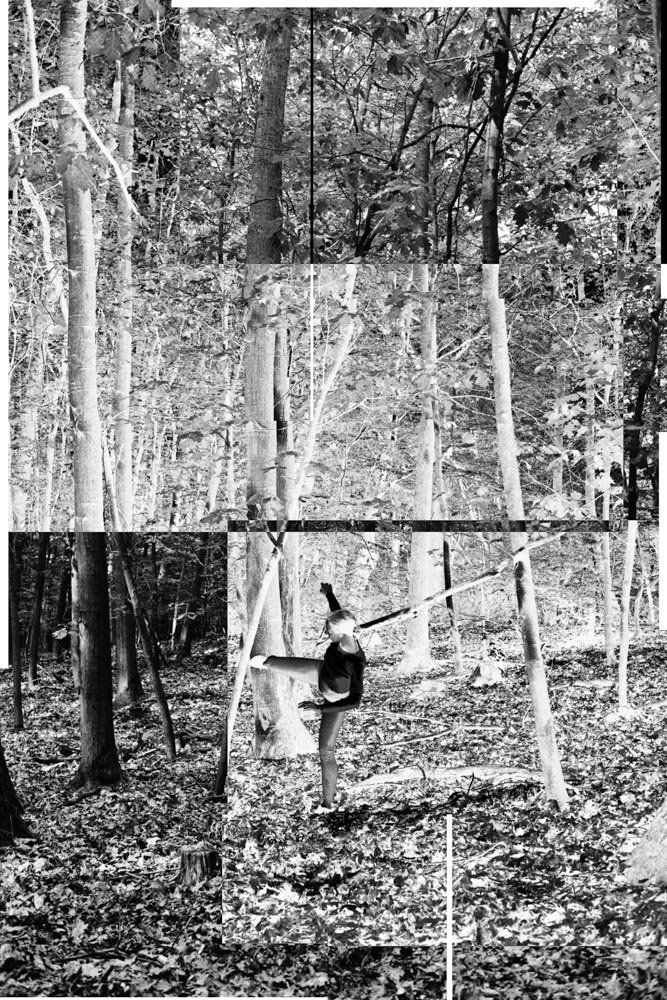INTERVIEW


ART HABENS ART REVIEW SPECIAL EDITION
PUBLISHED ON MAY 4, 2020
(TRANSCRIPT)
An interview by Josh Ryder, curator and Babara Scott, curator, arthabens.biennale@europe.com
Hello Eun Sun and welcome to ART Habens. Before starting to elaborate about your artistic production we would like to invite our readers to visit
https://www.eunsuncho.com and we would start this interview with a couple of questions about your background. You have a solid formal training: after your studies in Architecture at the Univeristy of Seoul, you moved from South Korea to Germany to study Photography at Neue Schule für Fotografie and you are currently pursuing your degree in Mathematics at the Technische Universität Berlin: how did those formative years influence your evolution as an artist? Moreover, how does your cultural substratum due to your Korean roots and your current life in Berlin address the direction of your current artistic research?
Eun Sun Cho : Architecture, Photography and mathematics create specific kind of language towards reality. The approach of the widely used diagram in architecture helps me analyse and summarise the scattered and seemingly irrelevant informations into the systematic visual language which deploys for functional architectural implementation. Architectural practice was for me the simultaneous task that copes with art/design, engineering, social, political, psychological and economic context in the form of the plan taking account of the possibility of realisation. On the other hand, Photography is a visual language that embodies spontaneity as well as methodicalness interplaying with the instantaneous phenomenon on the level of the surface. In mathematics, I am still in the middle of exploring the various aspect of mathematics. I can say that it is quite interesting to theorise the information pertaining to the reality in terms of axioms, theorems, conjecture. It gives me much intellectual freedom to nurture the structure of thoughts in the realm of formula corresponding to the simplified actuality. So I could say that my artistic research is based on Photography as a combination of light and writing in the etymological sense from which explores the fundamental theoretical part of the light through the perspective of chemistry, physics and mathematics and reconstructs reality through the synthetic language of architecture.
Encapsulating the influences from Korean root, suffice it to say impassioned driving forces towards the perfection in every aspect of work rather than the determination of specific direction. On the other hand, Berlin is a feline-faced city with international flair and diversity, which gives me enough space for the continual development of work with surging ideas. Acceptance and respect of difference is the most significant part that I appreciate about Berlin, which makes me feel free to experiment with different methods that I would not have thought of in Korea.
For this special edition of ART Habens we have selected DUAL SPACE AND TIME, an interesting project that explores the concepts of transience and displacement and that our readers have already started to get to know in the introductory pages of this article. What has at once captured our attention of DUAL SPACE AND TIME is the way you use your visual language in a strategic way to investigate the duality of light, to challenge the viewers' perceptual parameters. When walking our readers through your usual setup and process, would you tell us how did you develop your initial ideas for DUAL SPACE AND TIME in order to achieve such brilliant results?
Eun Sun Cho : While working on the projects about the format, units, materiality of photography, I felt the urge to develop the project about sheer light in the continuum of an element of photography. I did not know somehow at that time how to convey dual properties of light into photographic representation. By understanding the impossibility of depicting simultaneity of photon and wave state, I wanted to develop the work that imagines the state of simultaneous measurement and observation of two states. So it became clear for me to show the whole process of the state of light, namely from initial release of particle(exposing the light) to captivation of the particles in the net of grid(observation) to the mingle with the wave(transition) and to the coexistence of photon and wave state in the same frame(fictive state). In that sense, I wanted to explore the meaning of observation in the perspective of photography that snatches the duality of light. Each picture is an observation of constant changes of state which correspondences to one slice of a specific layer of time and space. Then I came across the idea of duality in mathematics which gave me an idea of how the duality of light could be presented visually. In mathematics, a duality, generally speaking, translates mathematical structures into other structures, in a one-to. So if two states of light are mere mathematical structures and if particle state is dual to wave and vice versa, then the depictability of coexistent states of particle and wave could be seen as somehow the union of dual spaces. This is how I got to the main idea of "Dual space and time".
We have particularly appreciated the way the delicate nuances that marks out DUAL SPACE AND TIME create such sense of dynamics. How does your own psychological make-up determine the nuances of tones that you decide to include in your artwork?
Eun Sun Cho : I must say that in the course of experimenting designated masterplans in the darkroom, also my spontaneous and fluctuated intervention marked on every layer of the pictures. Especially in the condition that you hardly see anything but rely on your dull tactile sensation, every movement at exposure done makes slight alteration from the imagined plan. The limitation of physical capability is often psychologically frustrating, and I have to accept that I am not the one who can control everything in the darkroom. On the other hand, I take a passive role of the observer of the physical phenomenon, which is surprisingly liberating. So the nuances of tones are determined by kind of let-go state of mind towards the phenomenon that is designed and planned to a certain extent with inhomogeneous lopsidedness caused by technical limitation.

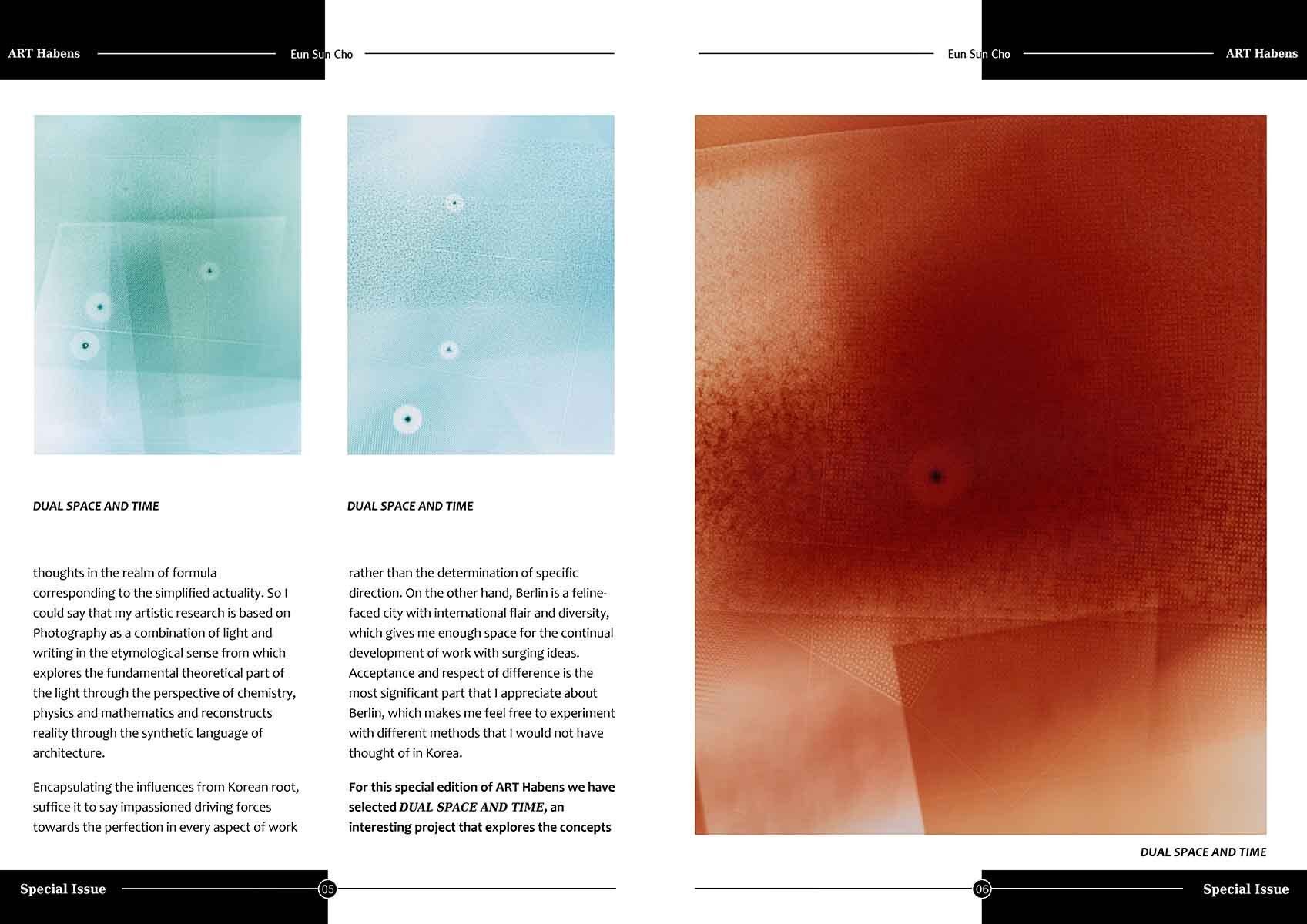
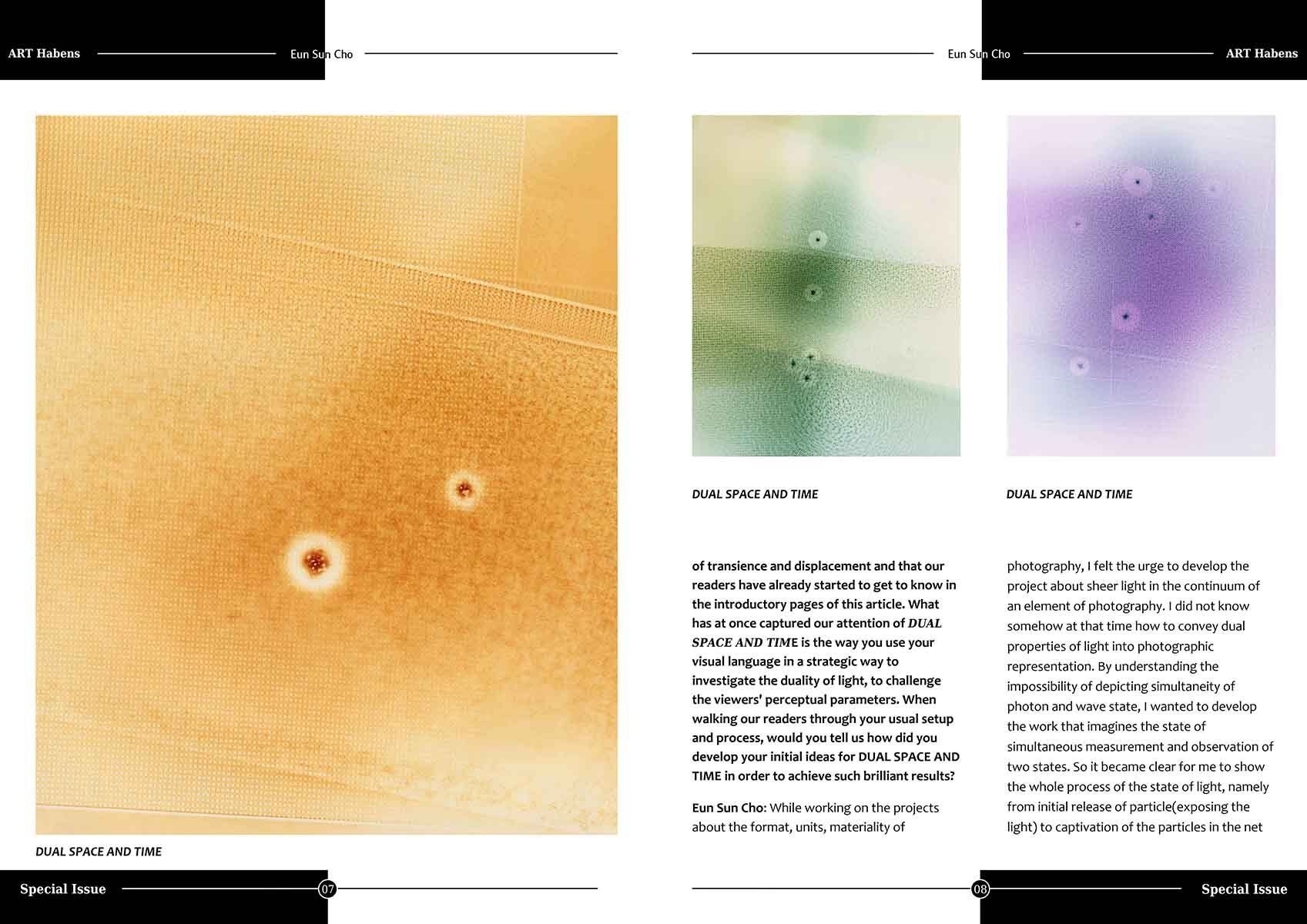

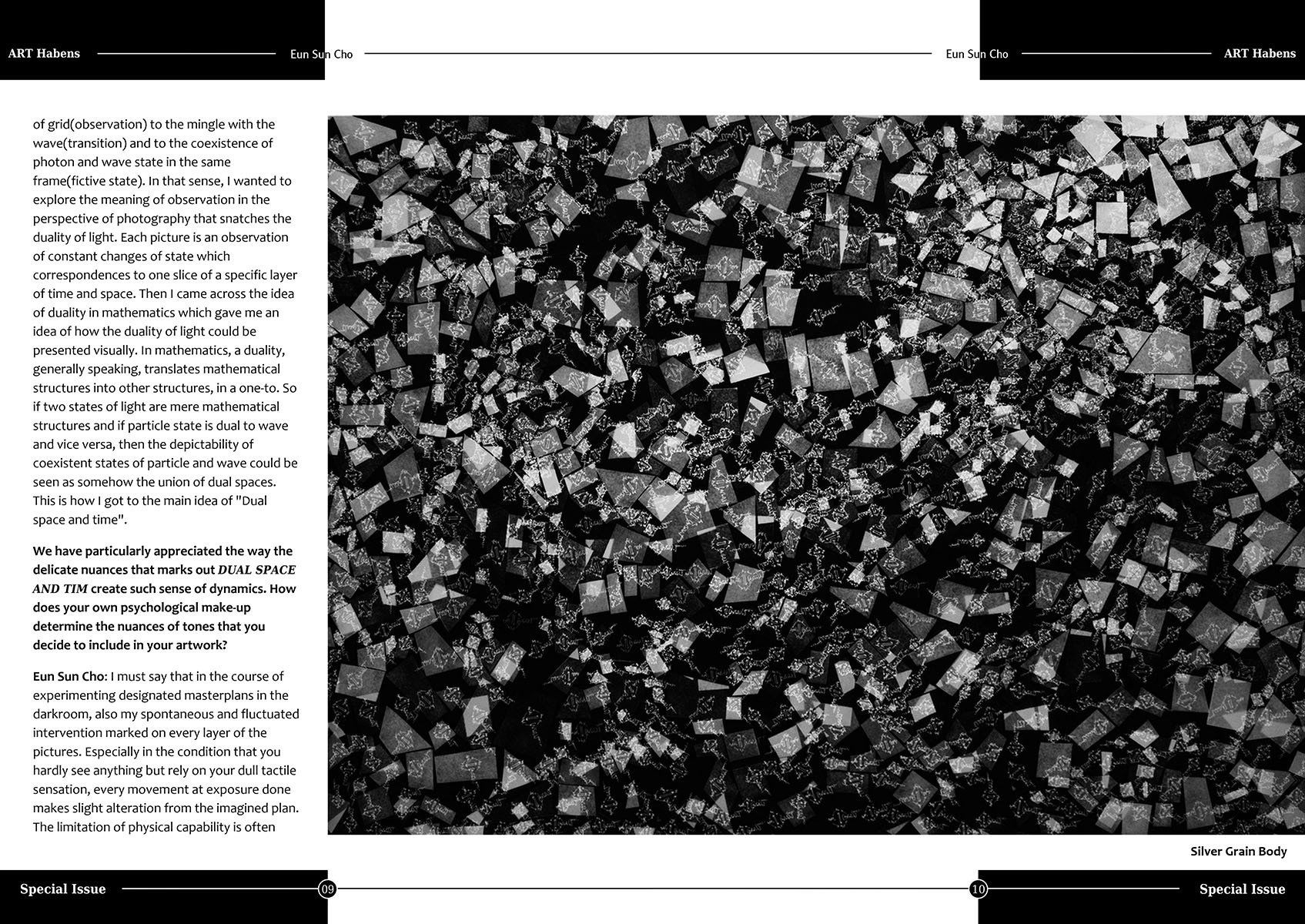
We have really appreciated your successful attempt to make visible the subliminal intercommunication between the distinctive languages, stimulating the viewer’s psyche on both the subconscious and the conscious level. In this sense, your artworks seem to invite the viewers to look inside of what appear to be seen, rather than its surface. Austrian Art historian Ernst Gombrich once remarked the importance of providing a space for the viewers to project onto: how important is for you to trigger the viewers' imagination in order to address them to elaborate personal interpretations? In particular, how open would you like your works to be understood?
Eun Sun Cho : I do think that it is essential to trigger the viewer's imagination for personal interpretation because through viewer's contribution to the artwork, the comprehension range of artwork could reach out to the affluent realm beyond the limitation of artist's intention and conception. An author of the work presents a specific framework for the work such as motivations and ideas behind it. And it is personally more about documenting my paths finely enough to infer from them that one could put various conception into coherence in a certain way. I reckon that as soon as every artwork leaves from the artist, it is handed to the viewers who have the right to freely interpret and reconstruct the artwork whether or not the artist intended the work to be seen in a specific way.
Another interesting project of yours that has particularly impressed us and that we would like to introduce to our readers is entitled Silver grain body. As you have remarked once, in your body of works analogue negative of portraits has exposed on the negative film, and then the enlarged positive film exposed repeatedly on another negative, so 20 times of the process. Each of enlarged portraits has been then cut into amorphous irregular pieces with diversified sized so that they imitate silver grain formation. How did you develop such unconventional technique in order to achieve such brilliant results?
Eun Sun Cho : I have done a lot of portrait series while studying at the Neue Schule für Fotografie Berlin because I thought it would be series. But ultimately, I realized that my interest flows into the intersectionality between scientific themes and photography, and I could not find any use for the portraits. Amid the frustration, then I had the strangest encounter with a woman in Berlin who claimed to be cloned by the government. It sounded just insane to me, but it revived my interest in modern biotechnology whether her story was true or not. From the research, I found out the cloning in biotechnology already existed in the same year that the structure of DNA was revealed. I intuitively felt from the story of the most cloned cell line(HeLa) in the world that it could have something to do with the photographic reality. So I wanted to develop the project starting from an analogue portrait to cell-like form which imitates forms of the silver grain in negative film. Also, it was essential to present the formula of the chemical process as well as the measurement of fictive grains since it is related to the reality of the technical aspect of analogue photography and biochemical means so that it arouses the blurriness of the line between physical body and body through Medium on the micro-level.
You investigate the intersection of biology, chemiphysical phenomena and mathematical problems with photographic reality and we have particularly appreciated the way you pratice highlights the Ariadne's thread that links Art to Science. How do you consider the relationship between artistic research and scientific method? In particular, how does in your opinion art could be used to explain science and vice versa?
Eun Sun Cho : The scientific method deals with systematic observation, measurement, experiment, and the formulation which apply for general principles. In artistic research, it is, in my opinion, more about the contextualization and representation of a specific idea, which is a dense process somehow without definite structure. So it is not exaggerating to say that the scientific method could compensate for the vagueness of artistic research with an elaborately structured and unambiguous way. I think in many cases that science could give an artist a new frame with the precision towards the phenomenon for which art applies. On the other hand, In science, many exciting subjects are not just approachable to the broad public because many theories behind the issues are explained based on demanding presupposition of the abstract formalized meaning of the phenomenon. Then in that sense art could serve to decipher the encapsulated scientific subjects by presenting well-paved accessibility experimentally with collections of focused perspectives.


We have appreciated the way Reconstruction of Architecture invites the viewers to question the way how human being interacts with the environment, highlighting the tension between the body and its surroudings. How do you consider the role of memory — including the places that you have had the chance to visit — playing within your process and how does everyday life's experience fuel your artistic research?
Eun Sun Cho : For „Reconstruction of Architecture“ I had various influences in terms of concepts over time. It took me some time to realize that the series would be part of the book „Ich und Du“ that I am preparing. At a certain point, I realized that the series like „land of land“ and „Invention of geometry“ reflects the zero ground status whereas „Reconstruction of Architecture“ deals with building elements in the physical world. By moving to Berlin, I had a chance to delve myself into a new language, culture and lifestyle which are so to speak to me building whole structure of myself once again from the bottom in a new surrounding. It actually helped me a lot to make a new life in the new environment again since I moved quite a lot from place to place as a child. So the combination of childhood memories and new life in Berlin have been the fuel of developing the Series „Reconstruction of Architecture“ as a metaphor for the restructuring the life.
With learning mathematics, my everyday life‘s experience somehow remains unperturbed and retain my composure with the intellectual challenge that I find the most fascinating. It keeps my work inside the sheer theoretical world with a specific structure that represents the concealed core of the mechanism of the physical phenomenon, which is the main interest in my artistic research.
In a controversial quote, German photographer Thomas Ruff stated that ''nowadays you don't have to paint to be an artist: you can just create photographs in a realistic way". Provocatively, the German photographer highlighted the short circuit between the act of looking and that of thinking critically about images: how do you consider the role of photography in our contemporary age, constantly saturated by ubiquitous images?
Eun Sun Cho : Through overload, overrun and overabundance by the images on an unprecedented scale in modern society, the cognitive effect is to be seen in every part of society, namely “photo-taking impairment effect” – the idea that photographing may discourage remembering. That implies at a certain point that we do not need to remember anything in a reality where photography becomes the life form in which everything is automatically photographed, and we could only cognize the world through the perspective of the photographed world. So, in that sense, the role of photography in our contemporary age is to resolve the discrepancy between photographed reality and our perception of it and its actuality, in my opinion.
Over the years your artworks have exhibited in several occasions, including your show at Nou Wave Gallery in London and at the Akademie der Wissenschaften und der Literature, in Mainz: how do you consider the nature of your relationship with your audience? Direct relationship with the viewers in a physical context is definetely the most important one, in order to snatch the spirit of a work of Art. However, as the move of Art from traditional gallery spaces, to street and especially to the online realm — as Instagram — increases: how would in your opinion change the relationship with a globalised audience?

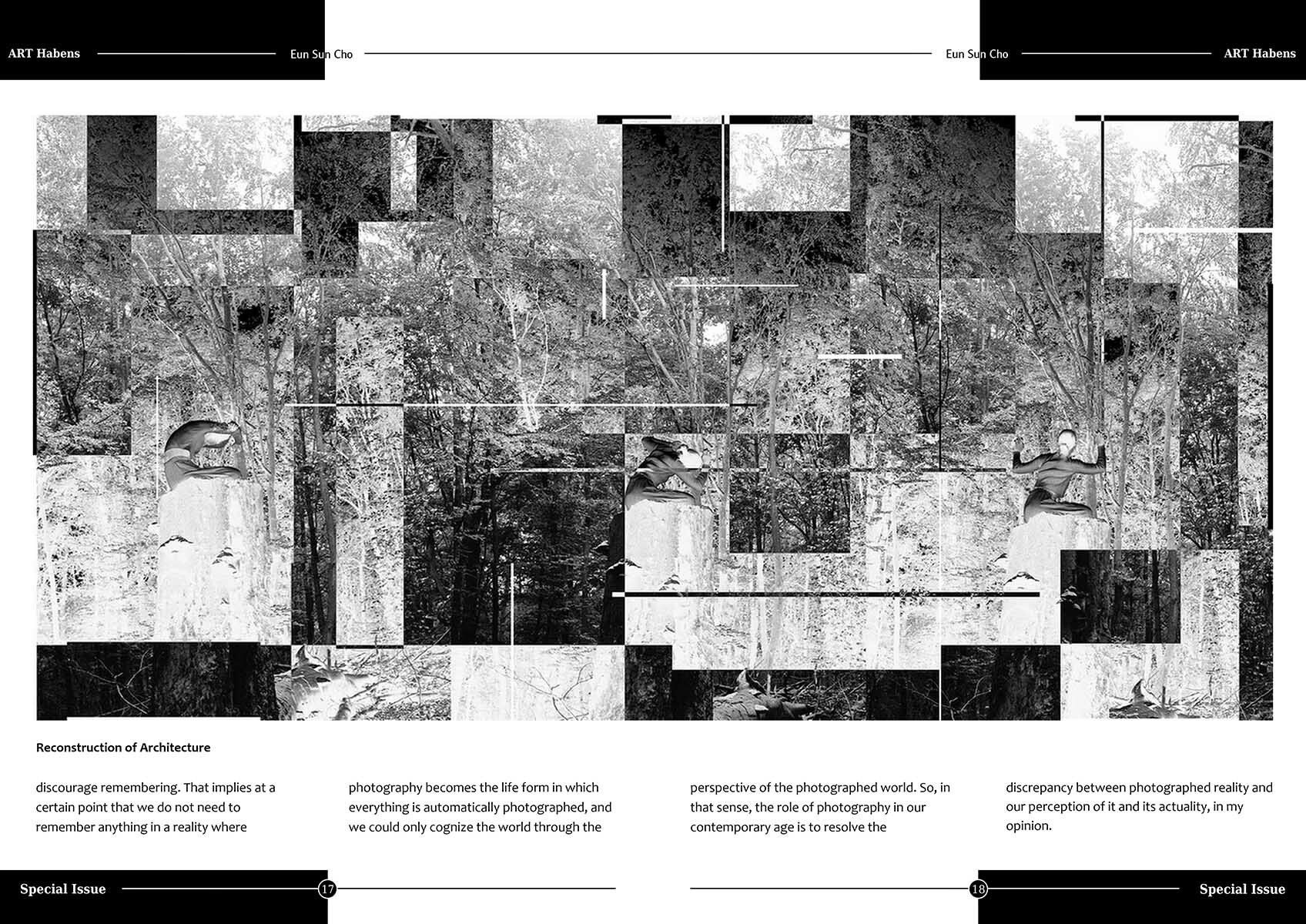
Eun Sun Cho : The physical exhibition is still advantageous in terms of contribution to the viewer‘s sensibility through physical involvement towards artwork as well as interpersonal interaction between viewers and artist since an artist can observe the reflection of the artwork on the base of reaction from the audience in physical space. Compared to the time and energy-consuming exhibition, the online platform is a very economical form of presenting the artwork. In the age of hyperconnectivity and globalism, I do think that it is inevitably necessary to give the work online for broad accessibility. Unfortunately, there is still a definite limitation of the online platform for it is fixed on retina-based 2-dimension. So the display of artwork in globalised online platform demands some kind of flatter and smoother standardised quality with the communication skill. For the globalised audience it opens the possibility to discover new talent quite quickly and easily, it is worth also mentioning, however, that it does not necessarily guarantee the intensity and quality of art experiences that they perhaps wish to seek for.
We have really appreciated the originality of your artistic production and before leaving this stimulating conversation we would like to thank you for chatting with us and for sharing your thoughts, Eun Sun. What projects are you currently working on, and what are some of the ideas that you hope to explore in the future?
Eun Sun Cho : Currently, I am editing the photo book project "Ich und Du " that I have been working on the last eight years on and off. It is about the human condition in a different contradistinctive environment which will include the project "Reconstruction of architecture" I am partially introducing here. Moreover, there is a project dealing with a pesticide in cooperation with Heinrich Böll Foundation in which I am due to take part. More personally, I would like to explore the correspondence between visual representation and mathematical manipulation behind, more specifically algebraic-geometric problems underlying mathematical structure such as group, ring and field.
Visit
issuu.com/arthabens/docs/biennial.ed.xiii
PUBLICATION >
PROJECT >
